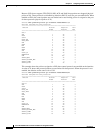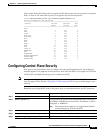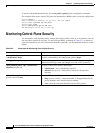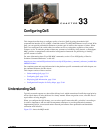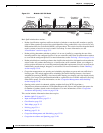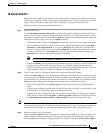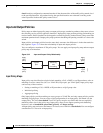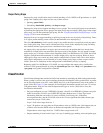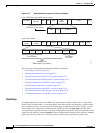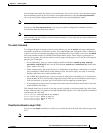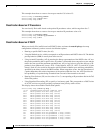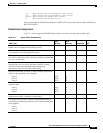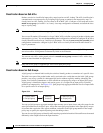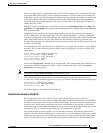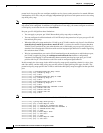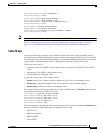
33-6
Cisco ME 3400 Ethernet Access Switch Software Configuration Guide
OL-9639-06
Chapter 33 Configuring QoS
Understanding QoS
Figure 33-3 QoS Classification Layers in Frames and Packets
These sections contain additional information about classification:
• “Class Maps” section on page 33-6
• “The match Command” section on page 33-7
• “Classification Based on Layer 2 CoS” section on page 33-7
• “Classification Based on IP Precedence” section on page 33-8
• “Classification Based on IP DSCP” section on page 33-8
• “Classification Comparisons” section on page 33-9
• “Classification Based on QoS ACLs” section on page 33-10
• “Classification Based on QoS Groups” section on page 33-10
• “Classification Based on VLAN IDs” section on page 33-11
Class Maps
As explained previously, you use an MQC class map to name a specific traffic flow (or class) and to
isolate it from all other traffic. A class map defines the criteria used to match against a specific traffic
flow to further classify it. If you have more than one type of traffic that you want to classify, you can
create another class map and use a different name. When you enter the class-map command with a
class-map name, the switch enters the class-map configuration mode. In this mode, you define the match
criterion for the traffic by using the match class-map configuration command. After a packet is matched
against the class-map criteria, it is acted on by the associated action specified in a policy map.
141151
Layer 2 IEEE 802.1Q and IEEE 802.1p Frame
Preamble
Start frame
delimiter
DA
Len
SA Type
TAG
2 Bytes
PT Data FCS
Layer 3 IPv4 Packet
Version
length
ToS
1 Byte
ID Offset TTL Proto FCS IP-SA IP-DA
PRI
7
6 5 4 3 2 1 0
CFI VLAN ID
Data
3 bits used for CoS
(IEEE 802.1p user priority)
IP precedence
DSCP
Standard IPv4:
MSBs called IP precedence
Flow control
for DSCP



